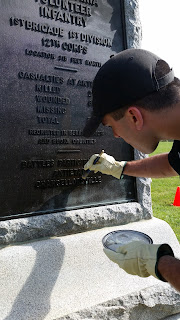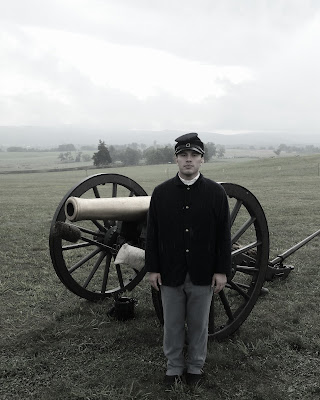Whichever direction you gaze upon
at Antietam Battlefield, there is probably a monument within your sight. Or there
is likely one just around the corner.
A portion of my week was speMont within the
cultural resource division. I shadowed the Exhibits Specialist, and he
started off by informing me about the latest work being done within the Mumma Cemetery.
The Mumma’s were a farming family that had their home burnt down by the
Confederates before battle. They also were members of the Dunkard Church. Their
family’s cemetery lies right outside of the existing farmhouse, which was
rebuilt after the battle. The work going on within the cemetery is
documentation of each headstone and tree within the space. There are also repairs
being made to headstones that need the preservative effort. Repairing massive headstones
is careful work, often involving building of custom braces and mixing the
correct chemical composition of epoxy for application. Along with the field work
going on in the cemetery, he talked about the research process in surfacing
more facts about each person and the symbolic ornamentation on their
headstones.
 |
| Treated Pennsylvania State Seal |
 |
| Wax Application |
After a
good introduction to the kind of work that went on in the division, we geared
up and began our project for the week. The project was to treat bronze plating on
monuments, in order to withstand oxidation. The process of treatment
consisted of heating the bronze plating and once hot enough we applied a coat
of wax to the protrusions of symbols, numbers, letters, and animals. A finished
treatment included two coats of heat wax, an applied cold wax, and brush
buffing. It was a powerful feeling to see the oxidized portion
of brass plating being wiped away with a simple brushstroke. One crucial
element to the bronze treatment, was being mindful of the expansive properties of
the materials while heating them. Needless to say, I’m happy that no stonework
was cracked due to poor handling of the propane torch used in treatment...the team had me a little nervous.
I also
rode along with our monument team on a trip to South Mountain State Park. We
took the ride to introduce me to and asses Park Service owned monuments that
were within the boundary of the state park. I believe I found my favorite
Antietam related monument in the War Correspondents Memorial Arch. The texture
and angles incorporated in the artist’s work were quite the sight.
The work this week was quite
rewarding. This was partially due to visitors making no effort to hide
their appreciation in the preservation of the battlefield monuments. I also
just found myself thinking that it was just a great thing to be a part of.
 |
| War Correspondents Memorial Arch |













































